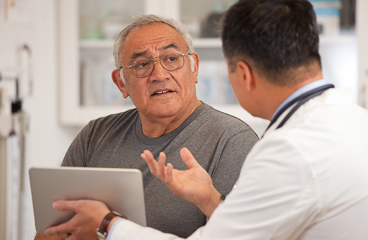
What is screening for lung cancer?
Lung cancer screening is a way to find some lung cancers early, before a person has any symptoms of the cancer.
Lung cancer screening may help those who have the highest risk for lung cancer—people age 50 and older who are or were heavy smokers. For most people, who aren't at increased risk, screening for lung cancer probably isn't helpful.
Screening won't prevent cancer. And it may not find all lung cancers. Lung cancer screening may lower the risk of dying from lung cancer in a small number of people.
How is it done?
Lung cancer screening is done with a low-dose CT (computed tomography) scan. A CT scan uses X-rays, or radiation, to make detailed pictures of your body. Experts recommend that screening be done in medical centers that focus on finding and treating lung cancer.
Who is screening recommended for?
Lung cancer screening is recommended for people age 50 and older who are or were heavy smokers. That means people with a smoking history of at least 20 pack years. A pack year is a way to measure how heavy a smoker you are or were.
To figure out your pack years, multiply how many packs a day on average (assuming 20 cigarettes per pack) you have smoked by how many years you have smoked. For example:
- If you smoked 1 pack a day for 20 years, that's 1 times 20. So you have a smoking history of 20 pack years.
- If you smoked 2 packs a day for 10 years, that's 2 times 10. So you have a smoking history of 20 pack years.
Experts agree that screening is for people who have a high risk of lung cancer. But experts don't agree on what high risk means. Some say people age 50 or older with at least a 20-pack-year smoking history are high risk. Others say it's people age 55 or older with a 30-pack-year history.
To see if you could benefit from screening, first find out if you are at high risk for lung cancer. Your doctor can help you decide your lung cancer risk.
What are the risks of screening?
CT screening for lung cancer isn't perfect. It can show an abnormal result when it turns out there wasn't any cancer. This is called a false-positive result. This means you may need more tests to make sure you don't have cancer. These tests can be harmful and cause a lot of worry.
These tests may include more CT scans and invasive testing like a lung biopsy. In a biopsy, the doctor takes a sample of tissue from inside your lung so it can be looked at under a microscope. A biopsy is the only way to tell if you have lung cancer. If the biopsy finds cancer, you and your doctor will have to decide how or whether to treat it.
Some lung cancers found on CT scans are harmless and would not have caused a problem if they had not been found through screening. But because doctors can't tell which ones will turn out to be harmless, most will be treated. This means that you may get treatment—including surgery, radiation, or chemotherapy—that you don't need.
There is a risk of damage to cells or tissue from being exposed to radiation, including the small amounts used in CTs, X-rays, and other medical tests. Over time, exposure to radiation may cause cancer and other health problems. But in most cases, the risk of getting cancer from being exposed to small amounts of radiation is low. It's not a reason to avoid these tests for most people.
What are the benefits of screening?
Your scan may be normal (negative).
For some people who are at higher risk, screening lowers the chance of dying of lung cancer. How much and how long you smoked helps to determine your risk level. Screening can find some cancers early, when treatment may be more likely to work.
What happens after screening?
The results of your CT scan will be sent to your doctor. Someone from your care team will explain the results of your scan and answer any questions you may have. If you need any follow-up, he or she will help you understand what to do next.
After a lung cancer screening, you can go back to your usual activities right away.
A lung cancer screening test can't tell if you have lung cancer. If your results are positive, your doctor can't tell whether an abnormal finding is a harmless nodule, cancer, or something else without doing more tests.
What can you do to help prevent lung cancer?
Some lung cancers can't be prevented. But if you smoke, quitting smoking is the best step you can take to prevent lung cancer. If you want to quit, your doctor can recommend medicines or other ways to help.
Follow-up care is a key part of your treatment and safety. Be sure to make and go to all appointments, and call your doctor if you are having problems. It's also a good idea to know your test results and keep a list of the medicines you take.
Where can you learn more?
Go to http://www.healthwise.net/patientEd
Enter Q940 in the search box to learn more about "Learning About Lung Cancer Screening".
Current as of: October 25, 2024
Author: Ignite Healthwise, LLC Staff
Clinical Review Board
All Ignite Healthwise, LLC education is reviewed by a team that includes physicians, nurses, advanced practitioners, registered dieticians, and other healthcare professionals.

